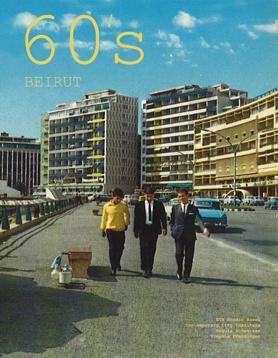60's Beirut

Students: Regula Schweizer, Stephie Pfenninger
Location: Beirut
Date: October, 2009
Type: Research project, student work
Background
The 1960s are considered as a period of strong economic growth, coinciding with times of libertarian spirit and cultural openness. Beirut was known for sophistication and elegance, even though the bulk of its inhabitants—many of whom were Palestinian refugees who left Palestine after the creation of Israel in 1948—shared in neither its prosperity nor its optimism. The city received many of the international film stars and jet setters, staying in the chic Saint George Hotel, the then center of the high society, and hanging out in the marinas or in the many bars and haut cuisine restaurants. It is this era which earned Beirut legendary status as a city of glamour and elegance.
Themes
The 1960s was also a time of rapid urban expansion. One main focus of urban growth was the coastal strip of Ras Beirut, called Raouche. It was here that virtually within 10 years the complete coastline was developed with swanky apartment blocks and new hotels, bars and resorts. The rugged waterfront with its famed pigeon rocks became the hub of the international flair that Beirut projected at that time. The architecture translated this cosmopolitan spirit into spatial form by creating something of a local adaption to a ‘Brazilian Modernism’. Buildings referenced elements of Niemeyer, Costa or Reidy and within few years created a unique skyline along Beiruts western coast. During the civil war the area underwent several fundamental changes. Initially it became the site of the souks and markets after these functions had to vacate the city center which had become virtually inaccessible. In 1982 it suffered heavily from the invasion of Israeli troops that used the nearby beaches as their landing sites. Today the area is experiencing another phase of transformation as the once glamorous buildings of late modernism are being neglected and mostly replaced by a Las Vegas style architecture.
Badaro, a neighborhood close to the National Museum, is a second quarter that developed throughout the 1960s and exhibits a unique style of ‘Mediterranean’ urbanism that has been better preserved, due to its location on the fringe of the city.
Project
What kind of concept of city development guided the expansion of Beirut in the 1960s in this area? Did this affect mostly single buildings or also reference an urbanistic dimension? Can a relationship be drawn between the Beirut lifestyle of the 1960s and its architecture? Trace the transformation that this area experienced during the time of the civil war and in the post war era. Were new concepts of urbanity introduced when developing this coastal strip in the 90s and in the new millennia? What is the future of the area? Compare the area to Badaro and its approach to architecture and street layout. How do the 60s of Beirut compare with the same era in Damascus?
Download the Book PDF

